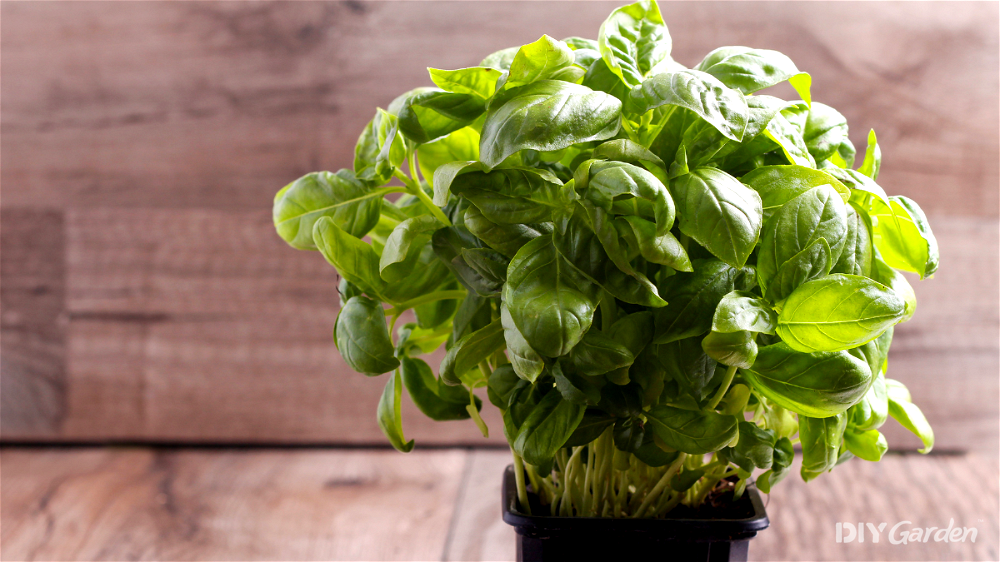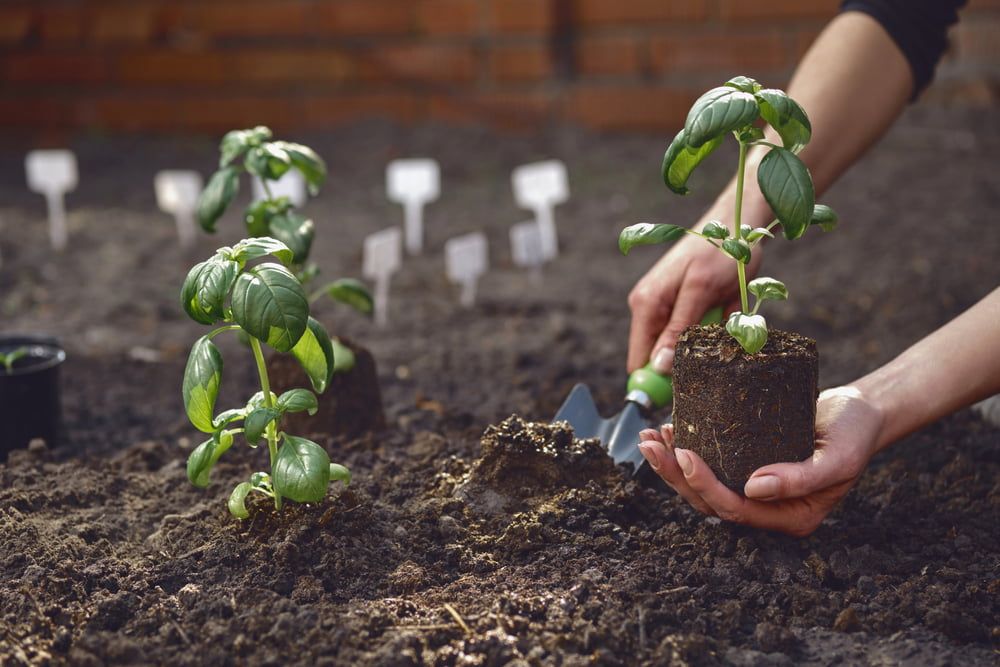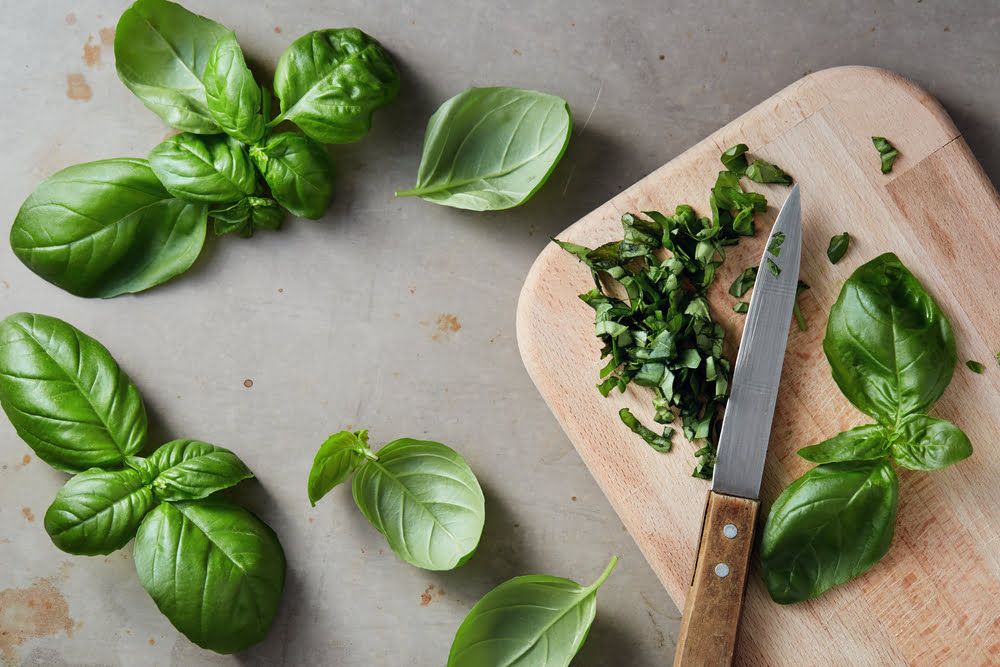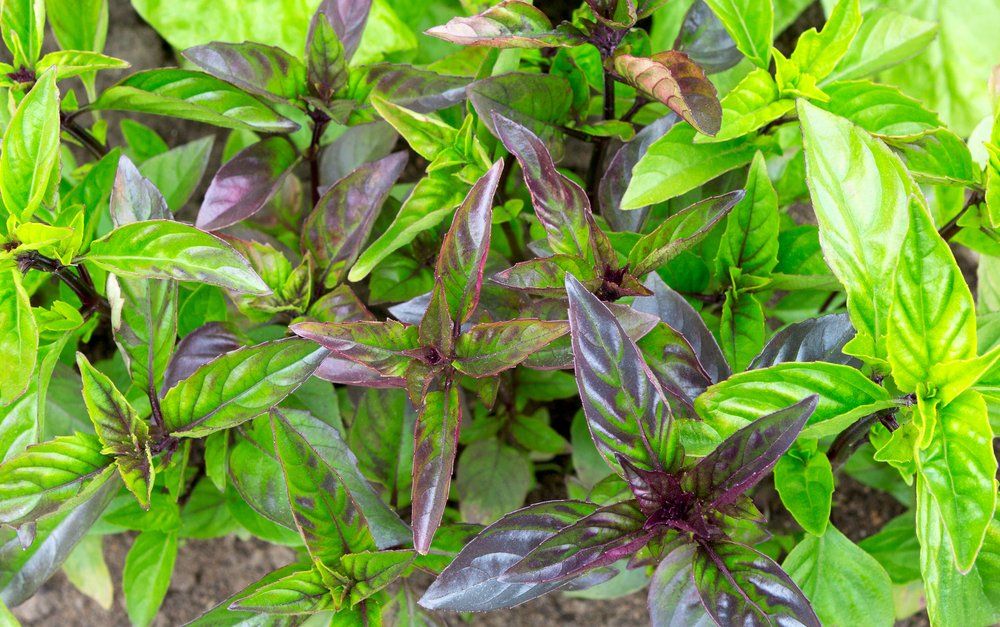
How to Grow Your Own Basil
Growing basil in the UK, where the climate can be cooler and less predictable than in the Mediterranean regions where basil thrives, requires some care to ensure a successful harvest.
Here’s our top guidance on how to grow basil plants in the UK:
1. Choose the Right Variety
- There are many varieties of basil, including sweet basil, Thai basil, and purple basil. Sweet basil is the most common and easiest to grow in the UK climate.
2. Sowing Seeds
- Basil is sensitive to cold, so start seeds indoors in early spring, around March or April. This gives the plants a head start before the warmer summer months.
- Sow seeds thinly in pots or trays using a fine seed compost. Cover lightly with compost or vermiculite.
- Keep the soil moist and place in a warm spot or on a heat mat to ensure good germination, which usually takes 7-14 days.
3. Providing Light
- Once seedlings emerge, they need plenty of light. Place them on a sunny windowsill or under grow lights to prevent them from becoming leggy.
4. Potting On
- When seedlings have two sets of true leaves, transplant them into individual pots filled with multi-purpose compost to give them more room to grow.
5. Hardening Off
- Before planting outside, acclimatize the basil plants to outdoor conditions by hardening them off. Start by placing them outside during the day in a sheltered spot for a week, gradually increasing their time outdoors.
6. Planting Outdoors
- After the risk of frost has passed, usually in late May or early June in the UK, plant basil outdoors in a sunny, sheltered spot. Basil thrives in temperatures between 10°C and 30°C.
- Plant basil in well-draining soil rich in organic matter. Space plants about 20-30cm apart.
7. Watering
- Keep the soil consistently moist but not waterlogged. Basil does not like to dry out completely, so water regularly, especially during dry spells.
8. Feeding
- Use a liquid plant food every 4-6 weeks during the growing season to encourage healthy growth and plenty of leaves.
9. Pinching Out
- Pinch out the tips of the plants when they are about 15cm tall to encourage bushy growth. Regularly harvesting the leaves also stimulates new growth.
10. Dealing with Pests and Diseases
- Basil can attract pests like aphids and slugs. Keep an eye out and deal with infestations promptly using organic methods where possible.
- Ensure good air circulation around the plants to prevent fungal diseases such as powdery mildew.
11. Harvesting
- Harvest basil leaves as needed throughout the summer. It’s best to pick leaves in the morning when their essential oils are strongest.
- For the best flavor, harvest leaves before the plant flowers. If you see flower buds forming, pinch them off.
12. Overwintering Basil
- Basil is not frost-hardy. To keep basil through the winter, pot up some plants in late summer and bring them indoors. Place them on a sunny windowsill and water sparingly.
Growing Basil: A Quick Snapshot
When to Sow – Feb-May
When to Plant – May-Aug
When to Harvest – May-Dec
Average Yield per Plant – 350g
Spacing – 15-30cm
Depth – 0.5cm
How to Grow Basil at Home
Basil isn’t a difficult plant to grow. It may technically be a tropical herb, but, so long as you’re able to meet its growing requirements, your plants will thrive during the warmer months of the year, no matter where you live.
Growing Requirements for Basil
Basil isn’t at all frost-hardy, meaning that you’ll need to get your timings right if you want to grow your plants outdoors. Having access to a greenhouse, or even a warm and sunny spot in your home, will allow you to significantly extend your growing season. Either way, basil ideally needs a minimum and consistent temperature of at least 15°C in order to properly grow.
In addition to heat, basil also loves the sun. Morning sun is best – aim to provide your plants with some afternoon shade to prevent leaf scorching, especially during the hotter months of the year.
When it comes to soil, basil grows well in a well-drained, neutral mix. Multi-purpose compost is usually ideal. Don’t use a soil mix that’s too rich, otherwise the leaves will lose some of their flavour.
How to Grow Basil from Seed
For frequent and regular harvests throughout the summer and autumn, sow your basil seeds successionally. Each time you sow, aim for about two plants per person in your household if you only plan on using your basil as a garnish. For those of you who want to preserve the leaves in some way, or make large batches of pesto, more plants will be needed.
How to Sow Basil Seeds:
- Fill small pots or module trays with a multi-purpose compost
- Water well, making sure that the water is able to drain out from the bottom of your containers
- Sow your seeds onto the surface of the soil, aiming for about 4-6 seeds per pot
- Cover the seeds over with about 0.5cm of compost
- Lightly water again before placing the pots in a warm location. Basil seeds germinate best at temperatures of around 21°C
Caring for Basil Seedlings
In about 7-10 days, you’ll notice basil seedlings starting to emerge. Wait until the seedings have grown their first set of true leaves before thinning them out. Snip away the weakest seedlings from each pot at their base, leaving one or two of the healthiest to continue growing.
Keep your seedlings moist, but don’t over-water them. Since you’ll need to keep them indoors until a while after your spring frosts have finished, you may also need to transplant them into larger pots if you notice roots making their way through the container’s drainage holes.
How to Plant Basil Outside
You need to be absolutely certain that there won’t be anymore cold snaps before planting your basil out. Ideally, wait a good few weeks after your last spring frost – the warmer the temperature outside, the better your basil plants will do.
Hardening off is also essential for basil. This will help it to acclimatise to outdoor conditions.
Choose a sunny and sheltered spot in your garden, and prepare your growing area. Then, dig holes that are large enough to accommodate each pot containing your basil seedlings. Ideally, you’ll be moving over the soil that your seedlings are growing in too, so as to prevent disturbing any roots.
Aim to space each plant between 15-30cm apart. The distance that you choose should not only depend on the variety that you’re growing, but also on how you intend to harvest your plants. If you plan on regularly picking the leaves, which will prevent the plants from growing too large, then a smaller spacing is fine. However, if you’d prefer to allow your plants to fully bush out in order to give you one large harvest, then they’ll need a bit more space.
Gently remove your seedlings from their pots and place them into their new homes. Cover back over with soil, lightly firm down, and then water well.
It’s usually beneficial to provide newly-planted basil with some extra protection for the first week or so. This could be in the form of a cloche, some fleece, or even just a few larger potted plants placed strategically around the basil to block strong winds.
How to Plant Basil in a Greenhouse
Basil loves the warmer temperatures of a greenhouse. Plants grow faster and yields are higher, with the only issue being that they’ll try to bolt earlier in the summer. However, if you’ve been sowing your seeds successionally, this shouldn’t be a problem, as you’ll always have new plants ready to take their place.
To plant basil in a greenhouse, follow the steps above for planting your seedlings outside.
You could also try direct sowing basil seeds in your greenhouse in late spring/early summer, giving you even lower-maintenance plants.
How to Care for Basil
Basil does require a certain amount of care. Without this, your plants will grow lanky and weak, before quickly bolting and then dying off. Don’t worry, caring for basil is easy, here’s what you need to do:
Watering Basil
Basil does best with about 2.5cm of water a week. This usually equates to a watering once a week, although you may need to increase this if the weather has been particularly hot or dry. However, while you never want your plants to dry out, be careful not to over-water either. Wet feet will lead to your basil plants discolouring and rotting.
Pruning Basil
If you want your basil plants to grow large and bushy, then you’ll need to regularly prune them. This process should start once your plants have about six sets of true leaves.
Use some sharp scissors to cut your basil plants back to just above their second set of leaves. This may seem severe, but it’ll encourage your plants to produce side shoots and start branching out, giving it a fuller and bushier appearance.
Repeat the pruning process each time your plants have grown 6-8 sets of leaves.
After about six weeks, it would also be a good idea to give the centre shoots of your plants a snip. Although this will affect growth, it will also prevent your basil from bolting quite so early. As a result, your harvesting season will be longer overall.
If you’re too late and notice that flowers have already appeared, simply pick these off. Just like everything you cut away when pruning your basil plants, the flowers are also edible.
Weeding and Mulching Basil
Basil plants struggle when they have to deal with competition from weeds. This makes it important to keep your growing area weed-free.
One way to do this is by laying a mulch around your basil plants. Practicing companion planting techniques will also help to reduce weed growth.
Feeding Basil
As mentioned earlier, basil doesn’t do well if its soil is too rich. However, it does also need a certain amount of nutrition for those leaves to grow in size and flavour.
A good compromise would be a balanced, general-purpose fertiliser, but used at a lighter-than-recommended concentration. Go for a liquid formula and apply this every couple of weeks.
How to Harvest Basil
If you’ve been pruning your basil plants, then this means that you’ve already been harvesting them. Keep at it, before ending with one final big harvest once your plants have fully bolted.
If you don’t plan on regularly pruning your plants, then you can simply snip away basil leaves as and when you need them. Harvesting can start once a basil plant has about 6-8 sets of leaves.
When harvesting your plants, keep an eye out for new leaf nodes growing on the stems. Try to leave about 2.5cm of stem above each leaf node when picking leaves, as this helps to encourage further growth.
How to Store Basil
Basil is all about flavour. Just like with other herbs, it tastes best when eaten fresh.
However, if you need to store a large harvest, then the best way to do this, in terms of flavour retention, is by freezing the leaves. Simply place the leaves into an air-tight bag and then store in your freezer for up to six months. You can also try blanching them first if you’d like to try to better preserve colour.
Another popular long-term storage method is drying. After the dried leaves have been crushed/ground, you’re left with a powder that’ll store for a couple of years and can conveniently be added to different dishes. The downside to the drying process is that the final product lacks both flavour and nutrients.
If you only have a few extra stems of basil to store, try placing these into a jar of water. Replace the water every couple of days and you’ll notice that not only do the stems start to grow new leaves, but roots will also emerge from the bottom! This is a great way to keep basil fresh in the short-term, while also propagating cuttings that can then be replanted for a flush of new harvests!
How to Prepare & Cook Basil
Basil is a simple herb to prepare. Give the leaves a quick rinse under running water, before gently patting them dry. You can then either tear them, chop them, or slice them, depending on how you plan on using the herb.
A staple in Italian cuisine, basil is so much more versatile than many realise. Using it solely as a garnish means that you’ll miss out on all that this herb has to offer. Instead, try one of the following dishes that feature basil as a star ingredient:
- A classic pesto
- Tomato and basil salad
- Basil-infused oil
- Basil bread
- Basil and lemon mayonnaise
- Basil panna cotta
- Basil sorbet
Common Basil Problems
Sadly, when it comes to pests and diseases, basil is prone to having problems from seedling-stage onwards. This can be avoided by ensuring that your growing conditions are optimum – most issues tend to affect weaker and over-crowded plants.
Aphids are the main pest to be on the lookout for. These tiny bugs cluster on the undersides of leaves and slowly weaken plants. They can be manually picked off, or sprayed off with a jet of water, so long as this isn’t going to damage your basil plants. There are also many organic aphid remedies out there, such as garlic sprays.
In terms of diseases, you could end up experiencing anything from grey mould to black spot. If you notice any sort of discoloration on your plants, look into this immediately. While some basil diseases can be treated, others can’t, meaning that you’ll need to remove your plants to prevent the disease from spreading.
Popular Basil Varieties to Grow
It’s estimated that there are more than 160 basil varieties out there. Most of these descend from culinary basil, meaning that you have plenty of choice when it comes to choosing which varieties to grow.
Some of the tastiest are:
- Genovese Basil – the classic Italian basil variety that has always traditionally been used for making pesto
- Lettuce Leaf Basil – these productive plants grow large, lettuce-sized leaves
- Dark Opal Basil – a beautiful purple variety
- Cinnamon Basil – loved for its spicy, cinnamon-like fragrance and flavour
- Spicy Bush Basil – these rounded, compact plants are perfect for growing in containers
- Sweet Thai Basil – a must-have ingredient for authentic Thai stir-fries
Conclusion
Growing your own basil not only gives you access to all you can eat of this flavourful herb, but, for those of you who regularly shop for basil, you’ll also find yourself saving money too. Plus, all of the many basil varieties out there make this humble herb surprisingly versatile in the kitchen – once you have your own supply, you’ll be finding so many new and exciting ways to make the most of this tasty and easy-to-grow annual.







